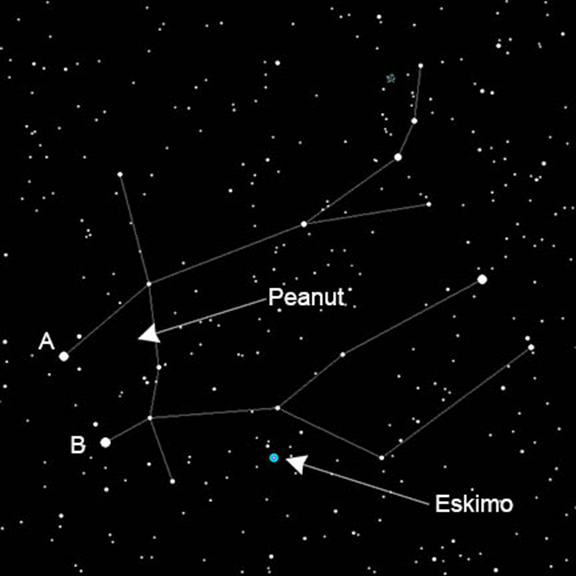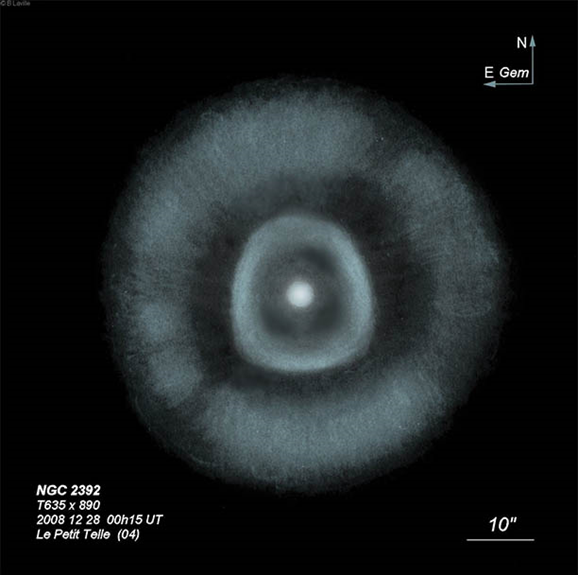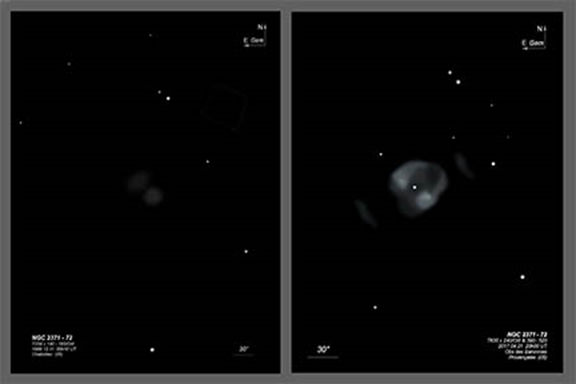
With Gemini well up in the evening sky, try for these two very different planetary nebulae: The Eskimo (NGC 2392) and The Peanut (NGC 2371/72). The Eskimo is a great favorite and easy to locate. Also known as the Clown Face Nebula and Lion Nebula, it is bright at magnitude 9.2 in a compact 45 arc-second shell. Its small size and high magnitude give this a high surface brightness compared to even brighter extended objects.
You can pick out great detail in this object, enhanced by use of a narrow-band filter such as Orion's Ultrablock. Details you can expect at high magnifications include a bright magnitude 9 central star, double shell separated by a dark ring, and a bright inner disk.

The Eskimo name is "recent" dating to 1962 when mentioned in William Liller's paper "Expansion Of Planetary Nebulae," was first confirmed as a planetary nebula spectrographically by Henry d'Arrest in 1872 with estimated distance of 6500 light years.
When viewed at high power under steady dark skies, this target can be a spectacular showpiece in its class of object. Here is a sketch by French amateur Bertrand Laville showing this superb target!

Image courtesy of Bertrand Laville. Used by permission
Now for the challenge target, NGC 2371/72 nicknamed the Peanut and the Double Bubble Nebula. Does this have two NGC (New General Catalogue) numbers for one object? Yes, as it is a bipolar object, much like the Little Dumbbell Planetary (Messier 76) in Perseus, and was originally viewed as two objects by John Draper. At a distance of 4400 light years, it shines at a much dimmer magnitude of 11.2 over its 74x54 arc-second size.
Look through your telescope with your narrowband filter at high magnification and pick out the bifurcated shape! Visual observer Steve Gottlieb described it as an "unusual planetary, bright, moderately large, elongated SW-NE. Two bright knots are at both ends (with two NGC designations) although the SW end is brighter and concentrated." You'll need a dark sky and large aperture telescope to rival Steve's view.
It was initially discovered by William Herschel on March 12, 1785 and noted as "the south-preceding of a curious bright double neb or an elongated bicentral neb; nuclei approaching to stars 45° nf or sp - distance of centre 60."
Here is a pair of Bertrand Laville sketches showing lower and high power views of this interesting object:

Image courtesy of Bertrand Laville. Used by permission
How large of a telescope do you need for these great targets? Why not try for them? Once you bag this pair, you'll want to search other targets in this object class. There are many, interesting to view through telescope, and in many cases truly awe-inspiring photographically, either in you own imaging or that of our great space telescopes.













